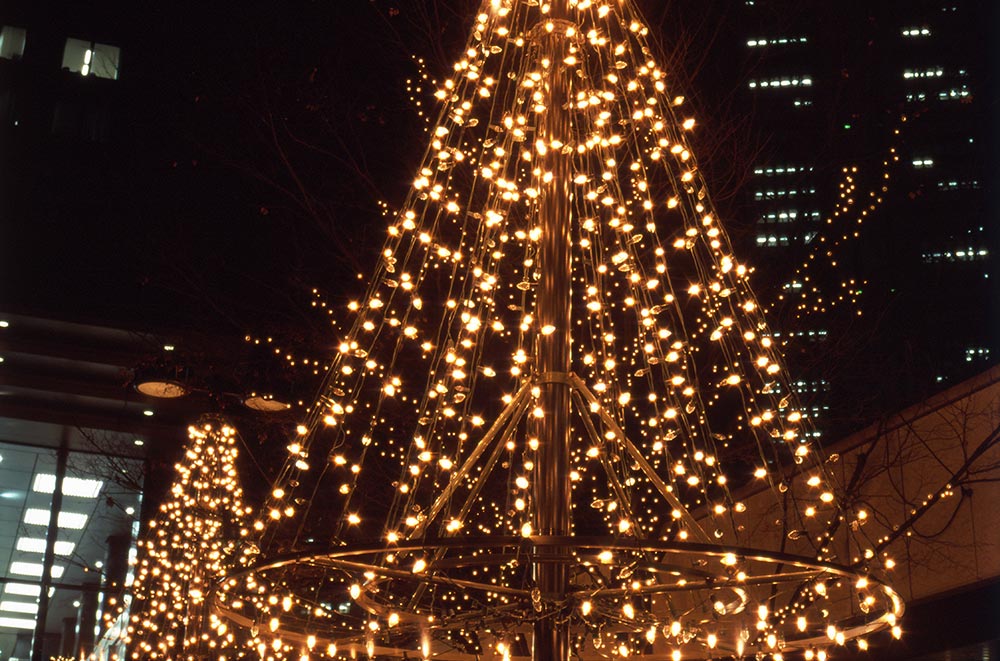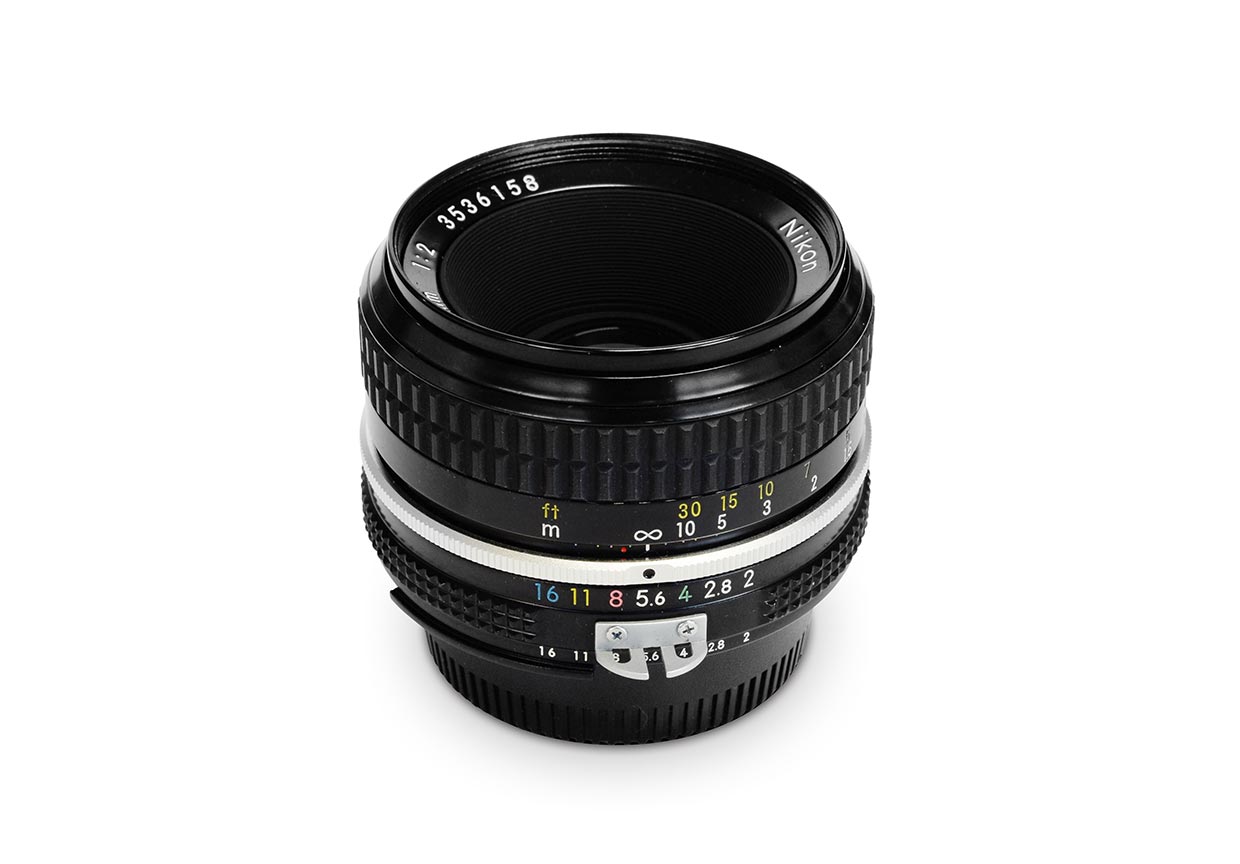NIKKOR - The Thousand and One Nights No.2

AI Nikkor 50mm F2
The 50mm lens has faded from view slightly, with the amazing advances in normal zooms over recent years, but when all is said and done the 50mm lens remains the "normal" for 35mm (135) format cameras.
This time, from the normal lenses, we look at a relatively unspectacular workhorse, the AI Nikkor 50mm f/2 lens.
by Kouichi Ohshita
I. Development of the 50mm f/2 lens configuration
Old Nikkor lensens fans will know that the first normal lens for the Nikon F was the NIKKOR-S Auto 5cm f/2.First we'll trace the development of the 50mm f/2 lens from the time that the Nikon F went on sale.
NIKKOR-S Auto 5cm f/2 (on sale June 1959)

This lens, the first normal lens for the Nikon F is a four(4)-group, six(6)-element Gaussian type with an additional weak concave element at the front, for a so-called retrofocus type lens of seven(7)-element construction. (See Fig. 1.)
As you know, for an SLR camera lens, the back focus must be sufficient that the lens does not interfere with the quick-return mirror, which makes the lens design harder the larger the aperture and the shorter the focal length. For this reason, at that time the normal lens for an SLR usually had a focal length slightly longer, at 55mm or 58mm.
The challenge for lens designers at that time was to bite the bullet, and increase the number of elements in the lens, to achieve a 50mm focal length.
NIKKOR-H Auto 50mm f/2 (on sale January 1964)

This lens went on the market five(5) years after the Nikkor-S, with a new optical configuration - a four(4)-group six(6)-element orthodox Gaussian type. (See Fig. 2.)
With advances in optical design technology, a Gaussian type optical system was now capable of providing adequate back focus for the design of a 50mm lens.
NIKKOR-HC Auto 50mm f/2 (on sale December 1972)
The optical system of this lens is unchanged from the NIKKOR-H, but has multi-layer coating.
Nikkor 50mm f/2 (on sale November 1974)
This was the "New" NIKKOR that marked the change from a silver and black two-tone design to a black body.
At the same time that the external design changed, the closest focusing distance was changed from 0.6m to 0.45m, thus boosting the close focusing ability which was a feature of the optical system.
AI Nikkor 50mm f/2 (on sale March 1977)
At the same time as the Nikon F2 Photomic A, Nikon EL2, and Nikomat FT3 bodies appeared with the AI coupled exposure meter system (automatic correction from fully-open f-stop), the AI version of this lens was released, with the optical system unchanged.
The year (1978) after this lens went on sale, the AI Nikkor 50mm f/1.8, with a slightly larger maximum aperture, was released, and the role of the AI 50mm f/2 as a normal lens in the ordinary price range ended when it was withdrawn in January 1979.
The slimmer AI Nikkor 50mm f/1.8 (The shorter lens barrel design model called "AI Nikkor 50mm F1.8S" in Japan), by the way, went on sale in the following year, 1980, together with the introduction of the Nikon EM in Japan.
Thus we can classify the 50mm f/2 lens by configuration into the five(5)-group seven(7)-element Nikkor-S Auto and the four (4)-group six (6)-element design of the subsequent lenses, and the AI Nikkor 50mm f/2 was the last model with the four(4)-group six(6)-element configuration.
II. nPerformance of the AI Nikkor 50mm f/2 lens
Next we look at the design features and optical performance of the AI Nikkor 50mm f/2.
As mentioned above, this lens is an orthodox Gaussian type, with a four (4)-group six (6)-element configuration. As can be seen from ((Fig. 2.)), the Gaussian type has a symmetrical arrangement of a convex lens and a concave doublet on either side of the aperture stop, with the concave surfaces facing the aperture stop. This type is widely used for large aperture normal and medium telephoto lenses.
A feature of this Gaussian type is the ability to correct the chromatic aberration and spherical aberration which tends to occur with a large aperture lens, and this lens exploits this characteristic to provide excellent correction of chromatic aberration.This lens also exploits glass with high refractive index and low dispersion to provide a much flatter image than the Nikkor-S.
We should also mention that the drop in performance for close-up work is small, and not only is the high quality maintained at the closest focusing distance of 0.45m (1.5ft.), but the lens also produces high quality when used on a bellows or extension rings for macrophotography.
The reasonable f/2 aperture means that coma can be easily corrected, and the sagittal coma flare which is a problem in large aperture lenses (turning points of light near the edge of the image into comet tails) is also relatively low.
By reducing the aperture by two stops, an image can be obtained with high contrast right to the edge of the image.
However, the spherical aberration is somewhat large when compared with a shorter lens barrel design model called "AI Nikkor 50mm f/1.8S"(1980~) in Japan, which was a further improvement on the AI Nikkor 50mm f/1.8 (1978~) and therefore the contrast is somewhat reduced at full aperture.
But this is a characteristic of the lens, and cannot be dismissed as an out-and-out defect.
In fact, this lens has a delicate balance of spherical aberration and residual peripheral coma flare, which together with the outstanding image flatness gives excellently uniform imaging over the whole image area from full aperture.
If we are just considering the image uniformity, then even among the many excellent lenses there are in this normal focal length, this is a top class item.
Thus, with few faults, this lens can stand comparison with the latest designs for its impressive performance. If we must give a drawback, it might be the very slight barrel distortion.
Of course this is absolutely no problem for normal work, but can slightly intrude in architectural work or macrophotography.
Compared with the previous model, the NIKKOR-S Auto and the AI Nikkor 50mm f/1.8 (1980~) mentioned above, which had almost zero geometrical distortion, it is something of a pity that this lens did not have quite as good correction.
III. Imaging characteristics of the AI Nikkor 50mm f/2
Well, let's look at the practical results that can be obtained with this lens.
I'd like to write about the capabilities of this lens from my own humble experience. But since personal preference inevitably enters into a discussion of the lens imaging character, please understand that this can in the end only be one person's view.
This lens exhibits a large change in imaging characteristics, from a distinctive fine and delicate image when fully open, to a crisp, high contrast when stopped down to f/4 or f/5.6.
If you own this lens, I recommend you to try taking a series of shots of a subject such as a nighttime scene, which is subject to flare, starting will the aperture stop fully open, and going down one stop for each exposure.
With the aperture stop fully open, light sources all over the image are surrounded by flare, yielding a fantastic image as though covered by a veil.
Except for the corners, there is little change in the shape of the flare, giving uniform flare across the image, and the flare core is small and neat.
This is related to the fine and delicate image the lens produces when fully open.
Going down one stop to f/2.8, the central flare is reduced, but still largely remains around the periphery.
Stop down to f/4 to f/5.6, and the flare is completely eliminated, and the image is sharp all the way to the corners.
The aperture stop is normally used to control exposure, soft focus effects, and depth of field, but having an idea of the changes in imaging characteristics with variations in the aperture will enable you to get just that little extra from the lens characteristics. One object is to find the aperture which gives you just the kind of image you like.
Personally, I like to use this lens either fully open, or at f/4 or f/5.6.
However, when fully open an out-of-focus background can become harsh or appear doubled, so handling the background requires care.

Nikon F-301, AI Nikkor 50mm f/2,
Aperture : f/2,
Shutter speed : Aperture priority
Film : FUJI ASTIA II
(C)1999 Kouichi Ohshita

Nikon F-301, AI Nikkor 50mm f/2,
Aperture : f/4,
Shutter speed : Aperture priority AE
Film : FUJI ASTIA II
(C)1999 OHSHITA, Kohichi
((Example 1.)) is a close-up of a "Sazanqua camellia", takes at closest focus (0.45m / 1,5ft.), aperture stop fully open.
The Sazanqua leaves are glossy, and the edges are serrated, which can produce bothersome blur. On the other hand, the buttery foreground blur is extremely attractive, as you can see.
For an AI lens, this one is unusual in having a six-bladed diaphragm.
This produces a hexagonal blur image when stopped down, with the possibility of producing night scenes where lights are surrounded by six (6) rays when the aperture stop is stopped down.
Later Nikkor lenses were designed with an odd number of diaphragm blades in order to eliminate these "rays" and the consequent loss of resolution, but there are creative possibilities in exploiting this effect for some scenes.
((Example 2.)) is an illumination scene, shot with the aperture at f/4 to eliminate flare.
This may not be clear on your monitor, but each individual light bulb has six (6) rays coming from it, giving a vivid sense of the illuminations.
It seems that every introductory book on photography includes a statement to the effect that: "A 50mm lens is the universal workhorse, that can function both as wide-angle and telephoto."
But one could also say that by the very fact of being a universal lens it tends to fall between two stools, and learning to use such a lens to the full is actually rather difficult.
As one normal zoom lens after another is developed, I suppose the truth is that the requirement for 50mm lenses has fallen from the days of the Nikkor Auto era.
However, a 50mm lens can offer superior imaging, and a large aperture unattainable by a zoom.
One often hears stories of a person who has only used a normal zoom and is given a 50mm lens for the first time, being amazed by the brightness and clarity in the viewfinder, the sharpness of the photos obtained, and the characteristic image depth that comes from a large aperture lens, and thus feeling that their ability with a camera has suddenly improved.
Of course these lenses are definitive when it comes to shooting in low light, but the 50mm lens is also ideal for bringing out an intimate depth in family snaps and portraits.
I often think of the 50mm lens as a "short medium-telephoto."
Though trying to learn how to use it as a universal lens may be difficult, think of it as just one of a set of interchangeable lenses, and the possibilities remain vast.
If this article reminds you of some of the excellent qualities of this normal lens, I will be satisfied.

NIKKOR - The Thousand and One Nights
The history of Nikon cameras is also that of NIKKOR lenses. This serial story features fascinating tales of lens design and manufacture.


